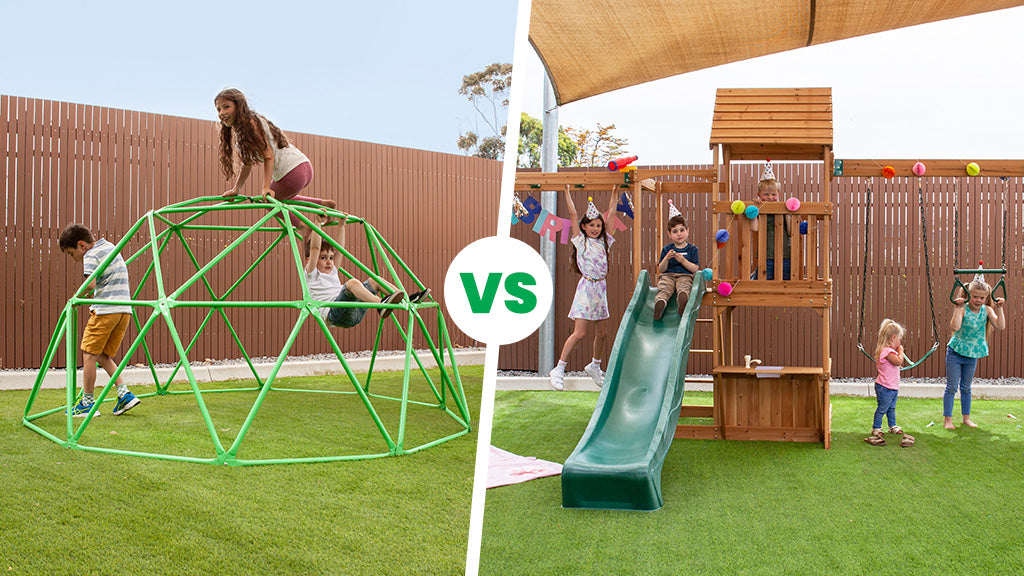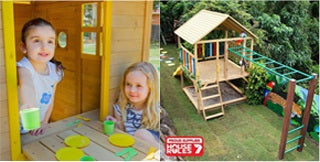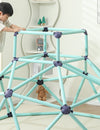The Blog
Dome Climbers vs. Traditional Play Structures: Which is Better for Your Child?

It's no secret that kids relish the opportunity to climb, scale and explore. Not only is it loads of fun, it provides a fantastic source of physical exercise, motor skill development and an outlet for social interaction. However, choosing the right play structure for your child can be a challenging decision. Dome climbers and traditional play structures each offer unique benefits and play experiences. Let's delve into the differences between the two to help you determine which option best suits your child's needs and preferences.
Why kids love climbing

For energetic little climbers, scaling different heights is an adventure that captivates their imagination and offers a multitude of benefits. First off, it's inherently enjoyable for children because it allows them to exert energy, test their strength and explore their physical capabilities in a dynamic and stimulating environment. Navigating obstacles and conquering challenges provide a sense of achievement and exhilaration that keeps children coming back for more. Climbing is also very often a social activity where children can interact and form friendships. Sharing the thrill of reaching new heights and celebrating achievements together creates lasting memories and strengthens social bonds among children.
What makes dome climbers unique

Dome climbers offer a distinctive play experience that sets them apart from traditional play structures. The geometric design of dome climbers creates a visually striking and intriguing play space for children. With its interconnected bars forming a dome-like structure, this design allows for endless climbing opportunities from all directions. Children are drawn to the challenge of navigating the varying angles and levels, stimulating their spatial awareness and motor skills in a fun and engaging way. This kind of climbing inspires creativity and exploration as children discover new paths and routes to climb. Unlike traditional play structures with predetermined paths, dome climbers offer a more open-ended play experience where children can choose their own adventure. They can climb up, down and sideways, experimenting with different techniques and strategies to reach the top. This freedom of movement encourages independence, decision-making and problem-solving skills, empowering children to explore their physical abilities and overcome obstacles at their own pace.
Traditional Play Structures

Traditional play structures have long been a staple in playgrounds and Aussie backyards, offering timeless fun and excitement for children of all ages. They typically feature a combination of slides, swings, climbing walls and monkey bars. They often resemble miniature obstacle courses, providing diverse play opportunities within a single structure. These structures are designed to accommodate multiple children simultaneously, fostering social interaction and cooperative play.
Traditional play structures offer several advantages that contribute to children's physical, social and cognitive development. They provide opportunities for active play and exercise, promoting physical fitness and motor skill development. Moreover, traditional play structures encourage imaginative play and creativity, serving as the backdrop for endless pretend scenarios and storytelling adventures. Children can role-play as explorers, pirates or superheroes, unleashing their imagination and developing their narrative and social skills in the process.
In doing all this, traditional play structures provide a rich and dynamic play environment that promotes physical activity, creativity and social interaction.
What to Consider

When choosing between dome climbers and traditional play structures, it's essential to consider several factors to ensure the best fit for your child's needs and preferences. First, consider the age of your child and their developmental stage. Younger children may benefit more from traditional play structures with low platforms, gentle slides and easy-to-reach features, while older children may prefer the challenge and complexity of dome climbers. Assess your child's climbing ability and confidence level. Dome climbers offer a more challenging climbing experience with varying angles and heights, which may be better suited for children who are more experienced climbers and seeking a greater challenge. Traditional play structures, on the other hand, provide a range of climbing options suitable for children of all skill levels.
Both dome climbers and traditional play structures offer valuable benefits for children's physical, social and cognitive development. Consider incorporating both types of structures into your child's play environment to provide a diverse and enriching play experience. This allows children to explore different play opportunities and challenge themselves in various ways, catering to their individual interests and preferences.
By considering these factors, you can make an informed decision that maximizes your child's enjoyment, safety, and developmental growth while fostering a love for active and imaginative play.
Creating a fun play space

Designing a fun and engaging play space for your child involves thoughtful consideration and creativity. You'll want to introduce a diverse range of play equipment to cater to different interests and preferences. If possible, combine traditional play structures, dome climbers, swings, slides and climbing walls to offer a comprehensive play experience that stimulates children's imagination and encourages exploration. Ensure proper installation and maintenance of all equipment to minimise risks and create a secure play environment for children to enjoy. Make play equipment accessible to children of all ages and abilities. Include features such as ramps, low platforms and wide pathways to accommodate children with mobility challenges and encourage inclusive play. Enhance the play experience with interactive elements such as sensory panels, musical instruments and sand or water play areas. These features promote sensory exploration, creativity and cognitive development while adding variety and excitement to the play space. Incorporate natural elements such as trees, plants, and rocks to create a visually appealing and harmonious play environment. Nature-inspired play elements encourage children to connect with the outdoors. Designate areas within the play space for imaginative play and creative expression. Include features such as playhouses, sandboxes and storytelling circles where children can engage in role-playing and pretend play activities that stimulate their imagination and social skills.
By incorporating multiple play equipment and thoughtful design elements, you can create a dynamic and inspiring play space that promotes active play, social interaction and joyful exploration for children of all ages and abilities.
Conclusion
Whether you choose a dome climber or a traditional play structure, the most important consideration is creating a safe and stimulating play environment that encourages children to explore and grow. Dome climbers offer unique challenges and opportunities for creative exploration, while traditional play structures provide a diverse range of play activities and social interactions. By considering factors such as age, climbing ability and the variety of play equipment, you can design a fun and inclusive play space that meets the needs and interests of children of all ages and abilities.
If you any questions regarding our range of climbing structures, or anything else that interests you, don't hesitate to get in touch with our friendly team and we'll be happy to help you out.















 Shop now, Pay Later
Shop now, Pay Later








